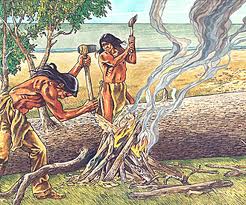
The Middle Archaic period in the Southeast is marked by a further intensification of regionalization of prehistoric cultures. A variety of new chipped stone points (for example, Stanly, Morrow Mountain, Levy, Eva, Benton, Cypress Creek, Arrendondo, White Springs, Sykes, and Newnan) and a series of ground stone tools and implements first appear in this period. These tools are used mainly for plant food processing.
The Middle Archaic appears to involve a very generalized resource exploitation strategy, which included the hunting of a variety of animals and the gathering of wild plants, such as nuts, fruits, berries, and seeds. This period demonstrated the first occurrence of shellfish collecting within river valleys and along the seacoast. At these “base” camps are found storage pits, remains of house floors, and prepared burials, all indications of increased sedentism at certain sites. Recent radiocarbon samples in Louisiana have provided considerable evidence of a mound-building tradition in Louisiana at least by 3000 B.C. There is also a moderate increase in the amount of trade in nonlocal chert materials supposedly due to a continued growth in prehistoric population. Trade networks that focused on specialized resources developed when people began to live in sedentary base camps.